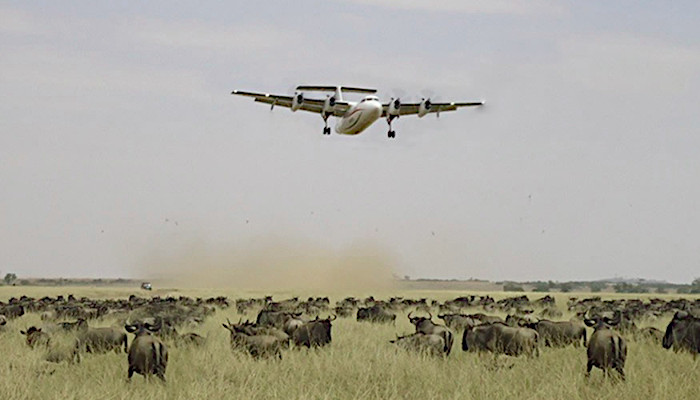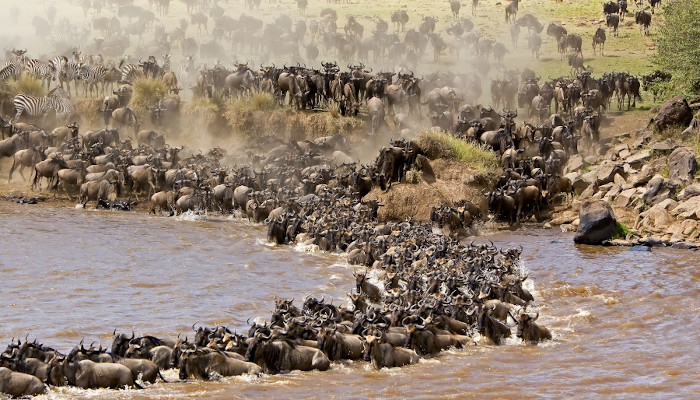Lake Manyara National Park
Located on the way to Ngorongoro Crater and the Serengeti, Lake Manyara National Park is worth a stop in its own right. Its ground water forests, bush plains, baobab strewn cliffs, and algae-streaked hot springs offer incredible ecological variety in a small area, rich in wildlife and incredible numbers of birds.
Lake Manyara’s famous tree-climbing lions are another reason to pay a visit to this park. The only kind of their species in the world, they make the ancient mahogany and elegant acacias their home during the rainy season, and are a well-known but rather rare feature of the northern park. In addition to the lions, the national park is also home to the largest concentration of baboons anywhere in the world — a fact that accounts for interesting game viewing of large families of the primates.
Manyara provides the perfect introduction to Tanzania’s birdlife. More than 400 species have been recorded, and even a first-time visitor to Africa might reasonably expect to observe 100 of these in one day. Highlights include thousands of pink-hued flamingos on their perpetual migration, as well as other large water birds such as pelicans, cormorants and storks.
Size: 330 sq km (127 sq miles), of which up to 200 sq km (77 sq miles) is the lake when water levels are high.
Location: Northern Tanzania. The entrance gate lies 1.5 hours (126km/80 miles) west of Arusha along a newly surfaced road, close to the ethnically diverse market town of Mto wa Mbu.
Stretching for 50km along the base of the rusty-gold 600-metre high Rift Valley escarpment, Lake Manyara is a scenic gem, with a setting extolled by Ernest Hemingway as “the loveliest I had seen in Africa”.
The compact game-viewing circuit through Manyara offers a virtual microcosm of the Tanzanian safari experience.
From the entrance gate, the road winds through an expanse of lush jungle-like groundwater forest where hundred-strong baboon troops lounge nonchalantly along the roadside; the blue monkeys scamper nimbly between the ancient mahogany trees; dainty bushbuck tread warily through the shadows, and the outsized forest hornbills honk cacophonously in the high canopy.
In contrast with the intimacy of the forest, is the grassy floodplain and its expansive views eastward, across the alkaline lake, to the jagged blue volcanic peaks that rise from the endless Maasai Steppes. Large buffalo, wildebeest and zebra herds congregate on these grassy plains, and so do the giraffes – some so dark in coloration that they appear to be black from a distance.
Inland of the floodplain, a narrow belt of acacia woodland is the favoured haunt of Manyara’s legendary tree-climbing lions and impressively tusked elephants. Squadrons of banded mongoose dart between the acacias, whereas the diminutive Kirk’s dik-dik forages in their shade. Pairs of klipspringer are often seen silhouetted on the rocks above a field of searing hot springs that steams and bubbles adjacent to the lakeshore in the far south of the park.
Manyara provides the perfect introduction to Tanzania’s birdlife. More than 400 species have been recorded, and even a first-time visitor to Africa might reasonably expect to observe 100 of these in one day. Highlights include thousands of pink-hued flamingos on their perpetual migration, as well as other large water birds such as pelicans, cormorants and storks.
Lake Manyara National Park is home to all three big cat species and is famous around the world for its population of tree-climbing lions. It’s not certain why the lions have adopted this unusual behavior – although experts theorize that the elevation gives them relief from biting insects or a better vantage point for spotting prey. Either way, the sight of these apex predators lounging high in an acacia tree is a remarkable one, and one that is particularly associated with Lake Manyara and Uganda’s Queen Elizabeth National Park.
Leopards also like to spend their daylight hours in the trees, so make sure to look upwards when on a Lake Manyara safari
.Tree-climbing lions aside, the park is known for its large elephant herds and baboon troops that often include several hundred members. Buffalos, zebras, Sykes’ monkeys, and various antelope species can also be spotted, including the diminutive dik-dik. The resident Maasai giraffe is the largest of all giraffe subspecies and consequently the tallest animal on Earth. At one end of the park, there’s a hippo pond where visitors can get out of their vehicles and admire the aquatic mammals wallowing, playing and fighting in the mud – from a safe distance, of course.
Lake Manyara is also a well-known birding hotspot with over 400 recorded species. In fact, the birdlife here is so abundant that even amateur ornithologists can reasonably expect to spot as many as 100 species in a single day. The lake attracts countless herons, egrets and other waders during the wet season, and is famous for the vast flocks of flamingos that congregate here from March to May. If you’re lucky, you may see thousands of these rose-colored birds amassed together along the lake shore.
Other specials include the Abdim’s stork, the African hawk-eagle, and the Von der Decken’s hornbill. In summer, migrant species arrive from Europe and Asia.
By Road: The road trip (road safari) from Arusha only takes 1 ½ to 2 hours to reach the entrance gate. Lake Manyara National Park is in a distance of 126 kilometers (also 78 miles from Arusha. Manyara Park is on the way to Ngorongoro crater and the Serengeti, most people prefer to take a day safari.
The months of June to October usually have few rains hence with the best weather whereas the worst weather is expected in March and April which is the peak of the wet season. June to September offers the best time to go as it is easier to view animals then.
The Dry Season
This is experienced during the months of June to October .Animals gather around water sources with thin vegetation where they are easier to find. There are lots of sun with little rains and since mosquitoes are very few, there are slighter chances of contracting malaria.
It tends to get cold in the mornings and you are therefore advised to bring warm clothes for game drives in June through August.
A yellow fever vaccination certificate. Also take medical evacuation insurance, malaria prophylaxis (consult your doctor), sun protection gear and creams, insect repellent and anti-histamine creams. Tsetse bites are harmless but painful, and often cause swellings that itch for days. Due to altitude mosquitoes or tsetse flies are not that common as at lower altitudes.

Best time to Visit Tanzania
The best wildlife viewing months in Tanzania are during the Dry season from late June to October. The best chance of seeing the wildebeest migration in the Serengeti is during June and July and the time to see the wildebeest calving is late January to February. The southern and western circuit parks are best visited during the Dry season (June to October).
Best Time : June to October ((Little to no rainfall)), June-July and January-February (Serengeti for the wildebeest migration and calving)
High Season : July to March (northern circuit parks; they get crowded), July to October (southern and western circuit parks; they don't really get crowded any time of the year)
Low Season: April and May (northern circuit parks still get quite a few visitors unlike the southern and western circuit parks, where many lodges close down)
Worst Weather: March and April (Peak of Wet season)
Tanzania Safari Packages
Choice of Safari holidays in Tanzania& tours from specialist, expert ... Small group travel: Departs most Sundays and selected Wednesdays throughout the year.

4 Days Tanzania Group Joining Budget Safari
4 Days Tanzania Group Joining Budget Safari - Adventure budget camping safari Tanzania. Experience unforgettable memorable Tanzania wildlife tour on this Tanzania ...

5 Days Tanzania Budget Campng & lodge Safari
5 Days Budget Tour is special tour package takes to Serengeti and other game ... takes to During this camping adventure in Tanzania National Parks by ... The begins of 5-Days Tanzania Budget Tour by picking you up from the hotel at Arusha ... Day 5: safari from Serengeti to Arusha via Ngorongoro crater.

7 Days Tanzania Budget Safari
This 7 day camping safari allows you to experience the highlights of the Northern Safari Circuit. You will experience breathtaking wildlife in the midst of some of the most diverse landscapes. You will also visit the world famous Serengeti National Park....

8 Days Tanzania Wildlife Camping and Lodge Safari
The 8 days safari will allow you to witness the best of the wildlife and best of birding experiences as you traverse the northen circuit in your Tanzania Safari. Savour the moments as you spend in some of the best lodges and camps beknown to Tanzania game safari circuit.

12 Days Nothern Tanzania Budget Wildlife Safari
Our 12 days Tanzania Safari and Zanzibar tour package will is combination safari involve wildlife safari Lodge or Tented Camping Safaris and beach vacation to Zanzibar Island. 13 days Tanzania And Zanzibar beach Is best package for Family or group of Friends to the game park including Serengeti famous for wildebeest migration later fly to Zanzibar for beach tour and vacation.

14 Days Kenya and Tanzania Wildlife Luxury Safari with Zanzibar Beach Holiday
Safari in the Masai Mara & paradise beaches on Zanzibar ... Luxury tailormade safari and beach holidays in Kenya .... Kenya and Tanzania tour, 14 days.....

20 Days Kenya Tanzania Gudget Group Safari with Zanzibar Beach Holiday
Kenya Budget Safaris | Tanzania Holiday | WildRace Africa Safari Tours ... small group tours and Safaris in Kenya and Tanzania Combined, Kenya and Tanzania ... parks Maasai Mara and Serengeti Safaris, Kenya wildlife and beach Holiday .... to amazing East African Safari destinations — Kenya, Tanzania, and Zanzibar.